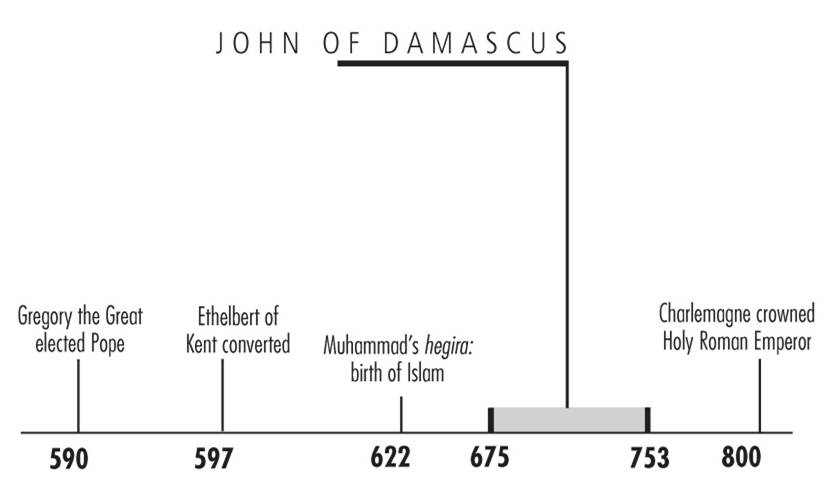
Theologians
John of Damascus
Image-conscious Arab
“I do not worship matter, I worship the God of matter,
who became matter for my sake and deigned to inhabit matter, who worked out
my salvation through matter. I will not cease from honoring that matter
which works for my salvation. I venerate it, though not as God.”
Visitors to an Orthodox Church are confronted with many
unfamiliar elements of worship: for example, the use of incense and
Byzantine chant and the custom of standing throughout the service. But
perhaps the most perplexing element is the icons, especially when Orthodox
worshipers bow before and kiss them. Isn’t this idolatry?
This very question raged through the Christian world in the
eighth and ninth centuries, and it occupied the attention of two of the
seven ecumenical (worldwide) church councils. The strongest defense of the
practice came from a Christian living in the heart of the Islamic empire,
John of Damascus.
Responding to the imperial volcano
He was born John Monsur, into a wealthy Arab-Christian
family of Damascus. Like his father, he held a position high in the court of
the caliph. About 725 he resigned his office and became a monk at Mar Saba
near Bethlehem, where he became a priest. In this secluded place at the
relatively advanced age of 51, John’s lasting legacy began to unfold. It
began when Emperor Leo III, in 726, outlawed the veneration of icons.
The conflict had been brewing for decades. It wasn’t a
question of bowing and kissing icons; this was a culturally acceptable way
to show respect. The basic question went deeper: are Christians allowed to
paint pictures of Jesus, or other biblical figures, at all? As Islam spread
through the Mediterranean region, bringing its absolute interdiction of
images, Christianity was feeling pressure to rid itself of images.
The main threat to icons came not from the Islamic caliph
but from the heart of the Byzantine Empire. A few bishops from Asia Minor
(now Turkey) believed the Bible, particularly the second commandment,
forbade such images:
“You shall not make for yourself an idol in the form of
anything in heaven above or on the earth beneath or in the waters below. You
shall not bow down to them or worship them.”
The bishops’ argument convinced Byzantine Emperor Leo III,
who set about to convince his subjects to abandon iconography. But a natural
disaster changed his approach. In 726 a violent volcano erupted in the
middle of the Aegean Sea and terrorized Constantinople, the capital.
Afterward, tidal waves buffeted the shores and volcanic ash extinguished the
sunlight. Leo reasoned that God was angry about icons. That’s when he
outlawed their use.
In 730 Leo commanded the destruction of all religious
likenesses, whether icons, mosaics, or statues, and iconoclasts (“image
smashers” in Greek) went on a spree, demolishing nearly all icons in the
Empire.
From his distant post in the Holy Land, John challenged this
policy in three works. He argued that icons should not be worshiped, but
they could be venerated. (The distinction is crucial: a Western parallel
might be the way a favorite Bible is read, cherished, and treated with
honor—but certainly not worshiped.)
John explained it like this: “Often, doubtless, when we have
not the Lord’s passion in mind and see the image of Christ’s crucifixion,
his saving passion is brought back to remembrance, and we fall down and
worship not the material but that which is imaged: just as we do not worship
the material of which the Gospels are made, nor the material of the Cross,
but that which these typify.”
Second, John drew support from the writings of the early
fathers like Basil the Great, who wrote, “The honor paid to an icon is
transferred to its prototype.” That is, the actual icon was but a point of
departure for the expressed devotion; the recipient was in the unseen world.
Third, John claimed that, with the birth of the Son of God
in the flesh, the depiction of Christ in paint and wood demonstrated faith
in the Incarnation. Since the unseen God had become visible, there was no
blasphemy in painting visible representations of Jesus or other historical
figures. To paint an icon of him was, in fact, a profession of faith,
deniable only by a heretic!
“I do not worship matter, I worship the God of matter, who
became matter for my sake and deigned to inhabit matter, who worked out my
salvation through matter,” he wrote. “I will not cease from honoring that
matter which works for my salvation. I venerate it, though not as God.”
Eastern theologian for the whole church
While the controversy continued to rage, John spent his days
at Mar Saba monastery in the hills 18 miles southeast of Jerusalem. There he
wrote both theological treatises and hymns; he is recognized as one of the
principal hymnographers of Eastern Orthodoxy. His most important theological
work, The Fount of Wisdom,
is a summary of Eastern theology.
Tradition says that his fellow monks grumbled that such
elegant writing was a distraction and prideful; so John was sometimes sent
to sell baskets humbly in the streets of Damascus, where he had once been
among the elite.
After more dissension and bloodshed over icons (the decade
after John’s death, over 100,000 Christians were injured or killed), the
issue was finally settled, and icons are an integral part of Orthodox
worship to this day. His other writings were major influences on Western
theologians such as Thomas Aquinas. In 1890 he was named a doctor of the
church by the Vatican, and in this century, his writings have become a fresh
source of theological insight, especially for Eastern theologians.
Galli, Mark ; Olsen, Ted: 131
Christians Everyone Should Know. Nashville, TN : Broadman &
Holman Publishers, 2000, S. 24

